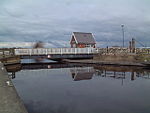Tetley, Lincolnshire
Borough of North LincolnshireDeserted medieval villages in LincolnshireHamlets in LincolnshireUse British English from December 2013
Tetley is a hamlet, between of the town of Crowle and the village of Ealand, in the North Lincolnshire district of Lincolnshire, England. It is in the civil parish of Crowle and Ealand. The hamlet is considered to be the site of a deserted medieval village and is known to have existed in 1316.Tetley Hall is a Grade II listed building dating from 1829 to 1839 for Henry Lister Maw, although its range is late 18th century, and built for George Stovin. The stables and granary are also Grade II listed.Near Tetley Hall is a limestone font which is perhaps from the mid-17th century, and possibly from the Protestant church in Sandtoft.
Excerpt from the Wikipedia article Tetley, Lincolnshire (License: CC BY-SA 3.0, Authors).Tetley, Lincolnshire
Park View,
Geographical coordinates (GPS) Address Nearby Places Show on map
Geographical coordinates (GPS)
| Latitude | Longitude |
|---|---|
| N 53.597064 ° | E -0.82888 ° |
Address
Tetley Hall
Park View
DN17 4HY , Crowle and Ealand
England, United Kingdom
Open on Google Maps









